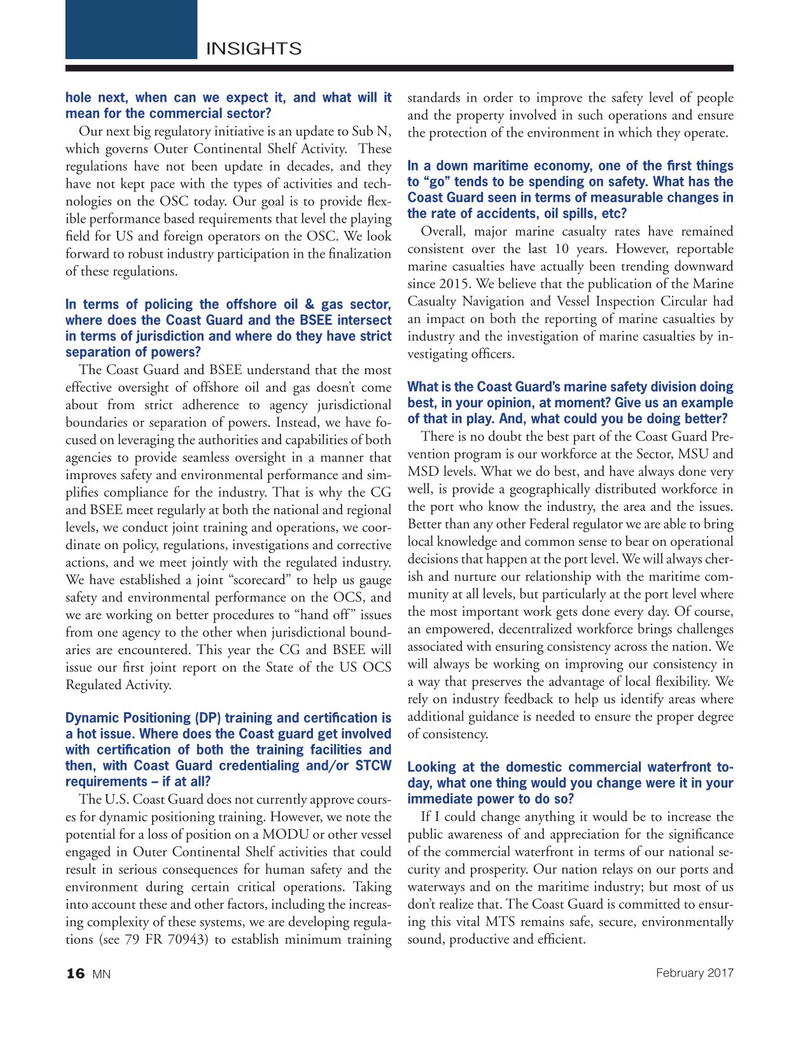
Page 16: of Marine News Magazine (February 2017)
Dredging & Marine Construction
Read this page in Pdf, Flash or Html5 edition of February 2017 Marine News Magazine
INSIGHTS standards in order to improve the safety level of people hole next, when can we expect it, and what will it mean for the commercial sector?
and the property involved in such operations and ensure
Our next big regulatory initiative is an update to Sub N, the protection of the environment in which they operate.
which governs Outer Continental Shelf Activity. These
In a down maritime economy, one of the ? rst things regulations have not been update in decades, and they to “go” tends to be spending on safety. What has the have not kept pace with the types of activities and tech-
Coast Guard seen in terms of measurable changes in nologies on the OSC today. Our goal is to provide ? ex- the rate of accidents, oil spills, etc?
ible performance based requirements that level the playing
Overall, major marine casualty rates have remained ? eld for US and foreign operators on the OSC. We look forward to robust industry participation in the ? nalization consistent over the last 10 years. However, reportable marine casualties have actually been trending downward of these regulations.
since 2015. We believe that the publication of the Marine
Casualty Navigation and Vessel Inspection Circular had
In terms of policing the offshore oil & gas sector, an impact on both the reporting of marine casualties by where does the Coast Guard and the BSEE intersect industry and the investigation of marine casualties by in- in terms of jurisdiction and where do they have strict separation of powers?
vestigating of? cers.
The Coast Guard and BSEE understand that the most
What is the Coast Guard’s marine safety division doing effective oversight of offshore oil and gas doesn’t come best, in your opinion, at moment? Give us an example about from strict adherence to agency jurisdictional of that in play. And, what could you be doing better?
boundaries or separation of powers. Instead, we have fo-
There is no doubt the best part of the Coast Guard Pre- cused on leveraging the authorities and capabilities of both agencies to provide seamless oversight in a manner that vention program is our workforce at the Sector, MSU and
MSD levels. What we do best, and have always done very improves safety and environmental performance and sim- pli? es compliance for the industry. That is why the CG well, is provide a geographically distributed workforce in and BSEE meet regularly at both the national and regional the port who know the industry, the area and the issues.
Better than any other Federal regulator we are able to bring levels, we conduct joint training and operations, we coor- dinate on policy, regulations, investigations and corrective local knowledge and common sense to bear on operational actions, and we meet jointly with the regulated industry. decisions that happen at the port level. We will always cher-
We have established a joint “scorecard” to help us gauge ish and nurture our relationship with the maritime com- safety and environmental performance on the OCS, and munity at all levels, but particularly at the port level where we are working on better procedures to “hand off” issues the most important work gets done every day. Of course, an empowered, decentralized workforce brings challenges from one agency to the other when jurisdictional bound- aries are encountered. This year the CG and BSEE will associated with ensuring consistency across the nation. We issue our ? rst joint report on the State of the US OCS will always be working on improving our consistency in a way that preserves the advantage of local ? exibility. We
Regulated Activity. rely on industry feedback to help us identify areas where additional guidance is needed to ensure the proper degree
Dynamic Positioning (DP) training and certi? cation is of consistency.
a hot issue. Where does the Coast guard get involved with certi? cation of both the training facilities and then, with Coast Guard credentialing and/or STCW Looking at the domestic commercial waterfront to- requirements – if at all? day, what one thing would you change were it in your immediate power to do so?
The U.S. Coast Guard does not currently approve cours- es for dynamic positioning training. However, we note the If I could change anything it would be to increase the potential for a loss of position on a MODU or other vessel public awareness of and appreciation for the signi? cance engaged in Outer Continental Shelf activities that could of the commercial waterfront in terms of our national se- result in serious consequences for human safety and the curity and prosperity. Our nation relays on our ports and environment during certain critical operations. Taking waterways and on the maritime industry; but most of us into account these and other factors, including the increas- don’t realize that. The Coast Guard is committed to ensur- ing complexity of these systems, we are developing regula- ing this vital MTS remains safe, secure, environmentally tions (see 79 FR 70943) to establish minimum training sound, productive and ef? cient.
February 2017
MN 16
MN Feb17 Layout 1-17.indd 16 MN Feb17 Layout 1-17.indd 16 1/26/2017 4:35:39 PM1/26/2017 4:35:39 PM

 15
15

 17
17
